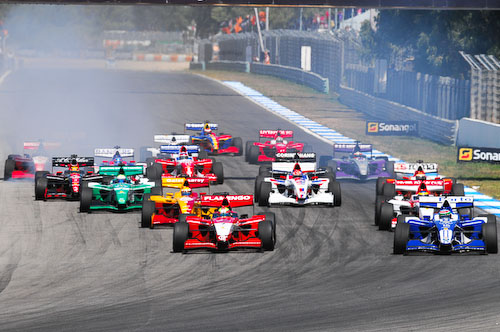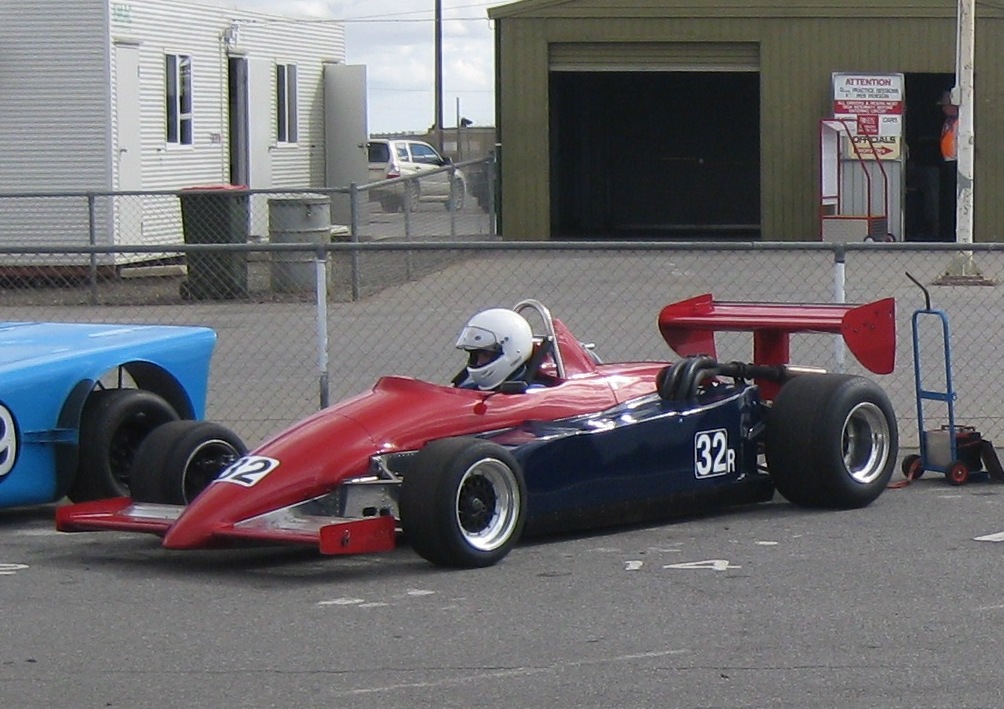|
Freddy Kottulinsky
Winfried Philippe Adalbert Karl Graf Kottulinsky Freiherr von Kottulin, better known as Freddy Kottulinsky (20 July 1932 – 4 May 2010), was a German-Swedish racing and rallying driver who won the Paris-Dakar Rally in 1980. He was born in Munich. Biography A member of old Austrian-Silesian nobility, in 1953 he went to Sweden, where he set up a repair shop. In the 1960s and mostly with a Swedish racing licence, Kottulinsky competed in Formula 3, Formula Vee and Formula 2. In F3 he became Swedish champion in 1966 on a Lotus 35 Cosworth. Together with Ronnie Peterson and Torsten Palm he in 1970 scored a Swedish win in the F3 European Cup for nations. In 1974 he won Formel Super V's European Gold Cup on a Lola T320. He also entered rallies, as did his daughter Susanne Kottulinsky who had been born in 1960. His granddaughter Mikaela Ă…hlin-Kottulinsky is also a racing driver in Audi Sport TT Cup. In 1980 he won the Paris-Dakar Rally together with Gerd Löffelmann in a 4WD VW ... [...More Info...] [...Related Items...] OR: [Wikipedia] [Google] [Baidu] |
Audi Quattro
The Audi Quattro is a road and rally car, produced by the German automobile manufacturer Audi, part of the Volkswagen Group. It was first shown at the 1980 Geneva Motor Show on 3 March. Production continued through 1991. Background The word ''quattro'' is derived from the Italian word for "four" to represent the fact that the vehicle delivers power to all four wheels. The name has also been used by Audi to refer to the quattro four-wheel-drive system, or any four-wheel-drive version of an Audi model. The original Quattro model is also commonly referred to as the Ur-Quattro - the " Ur-" (German for "primordial", "original", or "first of its kind") is an augmentative prefix. The idea of such a car came from the Audi engineer Jörg Bensinger. The Audi Quattro was the first rally car to take advantage of the then-recently changed rules that allowed the use of four-wheel drive in competition racing. It won consecutive competitions for the next two years. To commemorate the succe ... [...More Info...] [...Related Items...] OR: [Wikipedia] [Google] [Baidu] |
Hockenheimring
The Hockenheimring Baden-Württemberg () is a motor racing circuit situated in the Rhine valley near the town of Hockenheim in Baden-Württemberg, Germany, located on the Bertha Benz Memorial Route. Amongst other motor racing events, it has hosted the German Grand Prix, most recently in 2019. The circuit has very little differences in elevation. The circuit has an FIA Grade 1 license. History 1932–1938 Originally called "Dreieckskurs" (triangle course), the Hockenheimring was built in 1932. The man behind it is Ernst Christ, a young timekeeper who felt that a racing track should be built in his hometown of Hockenheim. He submitted the plans to the mayor and they were approved on Christmas day, in 1931. This first layout of the track was around twelve kilometres long and consisted of a large triangle-like section, a hairpin in the city and two straights connecting them. 1938–1965 In 1938, the circuit dramatically shortened, from twelve kilometres down to just over seven ... [...More Info...] [...Related Items...] OR: [Wikipedia] [Google] [Baidu] |
Thruxton Circuit
The Thruxton Circuit is a motor-racing circuit located near the village of Thruxton in Hampshire, England, United Kingdom, about 30 miles north of Southampton. It has hosted motorsport events including the British Touring Car Championship, British GT Championship, British Formula One Championship, British Formula Three, and GB3 Championship. It is often referred to as the "Fastest Circuit in the UK" where drivers can reach speeds of over and has earned the reputation of being a true driver's track. To illustrate this, Damon Hill drove his Williams Formula One car around the circuit at an average speed of in 1993. The site also houses the headquarters of the British Automobile Racing Club (BARC). History The site was originally constructed in 1942 as RAF Thruxton, a World War II airfield which was home to both the RAF and USAAF and was used for troop-carrying aircraft and gliders, including operations during the D-Day landings. Also, the paratroopers who took part in the ... [...More Info...] [...Related Items...] OR: [Wikipedia] [Google] [Baidu] |
AutĂłdromo Do Estoril
The Circuito do Estoril or AutĂłdromo do Estoril (Estoril Circuit), officially known as AutĂłdromo Fernanda Pires da Silva, is a motorsport race track on the Portuguese Riviera, outside of Lisbon, owned by state-run holding management company ParpĂşblica. Its length is . It was the home of the Formula One Portuguese Grand Prix from 1984 to 1996. The capacity of the motorsport stadium is 45,000. The circuit has an FIA Grade 1 license. History Estoril, a vacation-destination beach town located west of the Portuguese capital city of Lisbon has had a motor racing dating back to the 1930s, with a street circuit used in 1937 for a local race. The current Estoril circuit was built and completed in 1972 on a rocky plateau near the village of Alcabideche, from Estoril, the town lending its name to the circuit. The course has two hairpin turns, noticeable elevation changes, and a long start/finish straight. Its original perimeter was , and the maximum gradient is nearly 7%. Monsanto P ... [...More Info...] [...Related Items...] OR: [Wikipedia] [Google] [Baidu] |
BMW In Motorsport
Throughout its history, BMW cars and motorcycles have been successful in a range of motorsport activities. Apart from the factory efforts, many privateer teams enter BMW road cars in touring car racing. BMW also entered cars or provided engines in Formula One, Formula Two and sportscar racing. BMW is currently active in IMSA, the Isle of Man TT, the North West 200, the Superbike World Championship and the Deutsche Tourenwagen Masters (German Touring Car Championship). An outstanding role has been played by the 1,500 cc BMW M10 engine block. The four-cylinder started with modest in 1961, became successful in touring cars, developed over in 1970s Formula Two, and at the ripe age of a quarter century, produced almost twentyfold its original power in the 1986 turbocharged BMW M12/13/1, producing an outstanding 1400 hp. This engine became wideley regarded as one of the most powerful, if not the most, powerful engine in the history of Formula 1 as well as being the most pow ... [...More Info...] [...Related Items...] OR: [Wikipedia] [Google] [Baidu] |
Ralt
Ralt was a manufacturer of single-seater racing cars, founded by ex-Jack Brabham associate Ron Tauranac after he sold out his interest in Brabham to Bernie Ecclestone. Ron and his brother had built some specials in Australia in the 1950s under the Ralt name (standing for Ron and Austin Lewis Tauranac). Tauranac won the 1954 NSW Hillclimb Championship in the Ralt 500. Cars Early Ralts Built with the assistance of Tauranac's younger brother, Austin, in Australia. The Mk was powered by a 1,932cc pushrod Norton ES2. Tauranac made his own flywheel, connecting rods, and cylinders. The Mk2 was a sports car built by and for Austin, with a Ford 10 engine, Standard 10 gearbox, and Morris 8 rear axle. The Mk3 was purchased from the Hooper brothers when they retired. Tauranac designed a new chassis for it, and the car was primarily driven by Austin. The Mk4 began as a special, using a Vincent-HRD V-twin and a de Dion rear suspension. The car took two years to develop in Tauranac's spar ... [...More Info...] [...Related Items...] OR: [Wikipedia] [Google] [Baidu] |
:Template:Motorsport Driver Results Legend
{, style="margin-right:0; font-size:85%" class="wikitable" , - ! Colour !! Result , - style="background-color:#ffffbf" , Gold , , Winner , - style="background-color:#dfdfdf" , Silver , , Second place , - style="background-color:#ffdf9f" , Bronze , , Third place , - style="background-color:#dfffdf" , Green , , Points finish , - style="background-color:#cfcfff" , rowspan=2, Blue , , Non-points finish , - style="background-color:#cfcfff" , , - style="background-color:#efcfff" , Purple , , Retired (Ret) , - style="background-color:#ffcfcf" , rowspan=2, Red , , Did not qualify (DNQ) , - style="background-color:#ffcfcf" , {{nowrap, Did not pre-qualify (DNPQ) , - style="background-color:#000000;color:white" , Black , , Disqualified (DSQ) , - style="background-color:#ffffff" , rowspan=3, White , , Did not start (DNS) , - style="background-color:#ffffff" , Withdrew (WD) , - style="background-color:#ffffff" , Race cancelled (C) , - , rowspan="3" , Blank , Did not practi ... [...More Info...] [...Related Items...] OR: [Wikipedia] [Google] [Baidu] |
Karlstad
Karlstad (, ) is the 20th-largest city in Sweden, the seat of Karlstad Municipality, the capital of Värmland County, and the largest city in the province Värmland in Sweden. The city proper had 65,856 inhabitants in 2020 with 95,167 inhabitants in the wider municipality in 2021, and is the 21st biggest municipality in Sweden. Karlstad has a university and a cathedral. During recent years, Karlstad has started building many new buildings, for example all the new buildings around Orrholmen, hosting a brand new Coop store and a 17 story high rise apartment which will be finished in late 2022. Karlstad is built on the river delta where Sweden's longest river, Klarälven, runs into Sweden's largest lake, Vänern. It has the second largest lake port in the country after Västerås. Karlstad is often associated with sunshine and the symbol for Karlstad is a smiling sun. Karlstad is reputed to be one of the sunniest towns in Sweden and a local waitress, known as "Sola i Karlstad" ('' ... [...More Info...] [...Related Items...] OR: [Wikipedia] [Google] [Baidu] |
NĂĽrburgring
The is a 150,000 person capacity motorsports complex located in the town of Nürburg, Rhineland-Palatinate, Germany. It features a Formula One, Grand Prix race track built in 1984, and a long "North loop" track, built in the 1920s, around the village and medieval castle of Nürburg in the Eifel mountains. The north loop is long and contains more than of elevation change from its lowest to highest points. Jackie Stewart nicknamed the track "The Green Hell". Originally, the track featured four configurations: the -long ("Whole Course"), which in turn consisted of the ("North Loop") and the ("South Loop"). There was also a warm-up loop called ("Finish Loop") or ("Concrete Loop"), around the Pit stop, pit area. Between 1982 and 1983, the start/finish area was demolished to create a new , which is now used for all major and international racing events. However, the shortened is still in use for racing, testing and public access. History 1925–1939: The beginning of ... [...More Info...] [...Related Items...] OR: [Wikipedia] [Google] [Baidu] |
Datsun 240Z
The Nissan S30 (sold in Japan as the Nissan Fairlady Z and in other markets as the Datsun 240Z, then later as the 260Z and 280Z) is the first generation of Z GT 3-door two-seat coupĂ©s, produced by Nissan Motors, Ltd. of Japan from 1969 until 1978. The S30 was conceived of by Yutaka Katayama, the President of Nissan Motor Corporation U.S.A. and designed by a team led by Yoshihiko Matsuo, the head of Nissan's Sports Car Styling Studio. Aiming to compete directly with established European sports cars, Datsun priced the new 240Z within $200 of the British MGB-GT in the United States, a five-year-old design that showed its age. The 240Z's styling, engineering, relatively low price, and impressive performance resonated with the public, received a positive response from both buyers and the motoring press, and immediately generated long waiting lists. As a halo car, the 240Z broadened the acceptance of Japanese car-makers beyond their economy image. Datsun's growing dealer networkâ ... [...More Info...] [...Related Items...] OR: [Wikipedia] [Google] [Baidu] |






